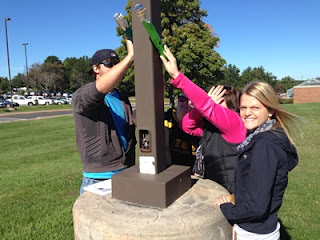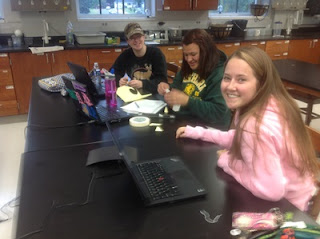This is a chronicle of teaching Earth System Science and Educational Technology at NMU. http://www.nmu.edu
Friday, September 27, 2013
Its like Stellarium before the interwebs
http://www.lawrencehallofscience.org/starclock/skywheel.html
A planisphere is a star chart analog computing instrument in the form of two adjustable disks that rotate on a common pivot. It can be adjusted to display the visible stars for any time and date. It is an instrument to assist in learning how to recognize stars and constellations. The astrolabe, an instrument that has its origins in the Hellenistic civilization, is a predecessor of the modern Planisphere. http://en.wikipedia.org/wiki/Planisphere
Monday, September 23, 2013
Sun King
Lesson Overview
Students determined the actual distance to the Sun without ever leaving the Earth, and in doing so will gained a better understanding of the huge distances in the Earth-Sun-Moon system. In order to determine these distances, students will apply their understanding of mathematical models in two different ways, using a single mathematical principle.
The Sun: The Supreme Ruler of the Solar System
The Sun is at the center of the Solar System. The eight major planets and their moons as well as the smaller bodies—such as dwarf planets, asteroids, and comets—all revolve around the Sun. The Sun’s role as the center and supreme ruler of the Solar System comes from its high mass: it has 99.8% of the mass in the system and, therefore, guides the movement of the other objects via gravitational forces. Sunlight brings energy to the rest of the Solar System and largely determines the conditions prevalent at the planets, from making the sunlit side of Mercury bake in 427ºC (800ºF) heat to providing the hospitable environment for life on Earth.
The Sun’s diameter is about 1.4 million km (865,000 miles), roughly 109 times Earth’s diameter. This is the same ratio as between the height of an NFL linebacker (185 cm) and the size of a honey bee (1.7 cm). The Sun is about 150 million km (93 million miles) away from Earth. The situation is similar to the honey bee hovering about two football fields away from the linebacker. The mass of the Sun is 1.99 × 1030 kg, or about 333,000 times Earth’s mass. This is the same ratio as between a linebacker (100 kg) and three honey bees (0.1 g each).
http://journeythroughtheuniverse.org/downloads/Content/Voyage_G58_L3.pdf
Friday, September 20, 2013
Impact craters
Impact craters are formed when impactors such as meteorites smash into the moon's surface. The factors affecting the appearance of impact craters include the size and velocity of the impactor and the geology of the surface. Students will use flour, baking soda and cornmeal to recreate a lunar surface. They will then drop impactors such as marbles onto their lunar surface from various heights. Finally, they will measure various characteristics of the impact craters formed.
http://www.nasa.gov/audience/foreducators/topnav/materials/listbytype/Impact_Craters.html
http://www.nasa.gov/audience/foreducators/topnav/materials/listbytype/Impact_Craters.html
Wednesday, September 18, 2013
Model rockets: DRY MIX
Flying model rockets is a relatively safe and inexpensive way for students to learn the basics of forces and the response of a vehicle to external forces. A model rocket is subjected to four forces in flight; weight, thrust, and the aerodynamic forces, lift and drag.
There are many different types of model rockets. The first and simplest type of rocket that a student encounters is the compressed air, or stomp rocket. The air rocket system consists of two main parts, the launcher and the rocket.
http://exploration.grc.nasa.gov/education/rocket/rktstomp.html
http://www.nasa.gov/pdf/295786main_Rockets_Adv_High_Power_Paper.pdf
WHAT STUDENTS DO: Test a rocket model and predict its motion. Curiosity about what lies beyond our home planet led to the first rocket launches from Earth and to many exploration missions since. Using simple materials (soda straws and paper), students will experience the processes involved in engineering a rocket. Conducting engineering tests, students will have the opportunity to answer a research question by collecting and analyzing data related to finding out the best nose cone length and predicting the motion of their model rockets. In this collection, this lesson builds on the concept of using models encountered in Lessons 1-3, and introduces the concepts of prediction and hypothesis.
http://mars.jpl.nasa.gov/participate/marsforeducators/soi/MarsSOI2012_Lesson5.pdf
When I teach dependent and independent variables I tie them into graphing and data collection.
When my students are looking at an experiment I tell them to ask the following questions to determine the variables.
1. What is being tested in the experiment? or What is the problem the experiment is to answer? (This directs you to the independent variable?)
2. What are the results in the experiment? or What are the outcomes in the experiment?
I also use the following Acronym DRY MIX.
DRY MIX also helps students create a graph from the data collect in experiments.
D-Dependent variable
R- Responding variable
Y- (goes on) Y-axis
M-Manipulated variable
I-Independent variable
X-(goes on) X-axis
Subscribe to:
Comments (Atom)


































































